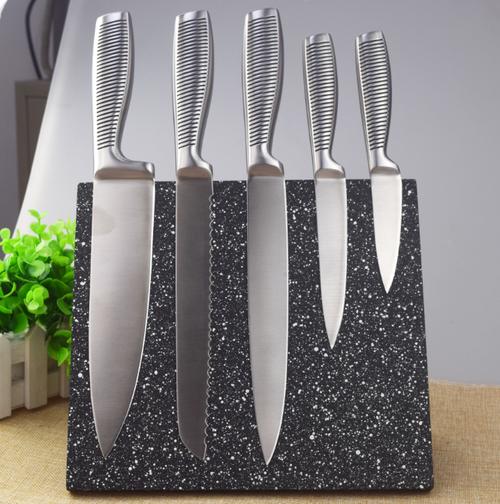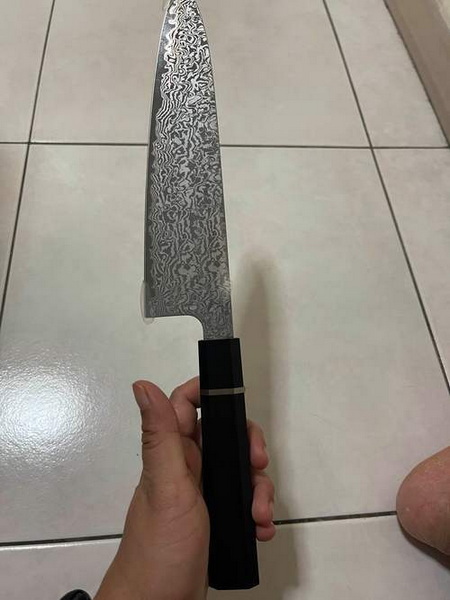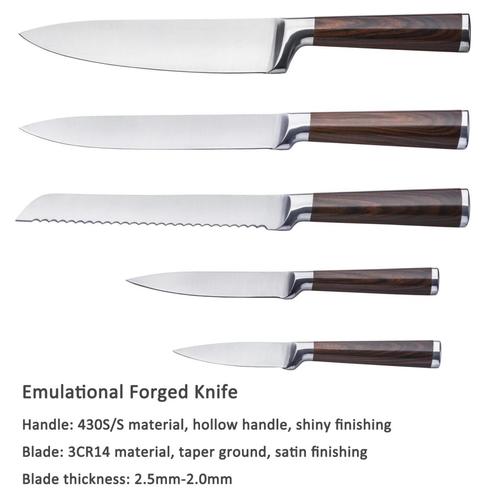

Views: 222 Author: Ella Publish Time: 2025-05-06 Origin: Site








Content Menu
● Understanding the Importance of Choosing the Right Knife Set
● Common Mistakes When Buying a Knife Set
>> 1. Focusing Solely on Price
>> 2. Ignoring Comfort and Handle Design
>> 3. Buying a Full Knife Set Without Considering Your Needs
>> 4. Overlooking Maintenance Requirements
>> 5. Not Researching or Testing Before Purchase
>> 6. Choosing the Wrong Knife Style for Your Kitchen
>> 7. Neglecting Storage and Safety Considerations
● How to Choose the Right Knife Set: Key Factors
>> Essential Knives to Include
>> Handle Material and Ergonomics
>> Maintenance and Sharpening Tools
● Frequently Asked Questions (FAQ)
>> 1. What knives should be in a basic knife set?
>> 2. Are expensive knife sets always better?
>> 3. How often should I sharpen my knives?
>> 4. Can I put my knives in the dishwasher?
>> 5. Is it better to buy a knife set or individual knives?
Buying a knife set can be an exciting yet daunting task, especially for those who love cooking or are setting up a kitchen for the first time. However, many people fall into common traps that lead to dissatisfaction, poor performance, or wasted money. This comprehensive guide explores the most frequent mistakes made when purchasing a knife set and offers practical advice to help you make the best choice.

Knives are fundamental tools in any kitchen. The right knife set enhances your cooking experience by making food preparation more efficient, safer, and more enjoyable. Conversely, the wrong set can cause discomfort, inefficiency, and even accidents. Knowing what to avoid will save you time, money, and frustration.
A well-chosen knife set not only improves cutting precision but also reduces the risk of injury. Sharp, balanced knives require less force, which means you have better control and less chance of slipping. The right knife set also complements your cooking style, whether you are a casual cook or a professional chef.
One of the biggest mistakes is choosing the cheapest knife set available. While budget is important, the lowest price often means poor-quality steel that dulls quickly, poorly balanced knives, and handles that cause fatigue. Investing in higher-quality knives made from durable materials like high-carbon stainless steel or Damascus steel ensures longevity and better performance, saving money in the long run.
Cheap knives often have blades that chip or bend easily. They may also lack proper heat treatment, which affects hardness and edge retention. In contrast, mid-range to premium knives are crafted with better metallurgy and undergo rigorous quality control. This results in blades that stay sharp longer and resist corrosion.
Many buyers overlook how a knife feels in their hand. A knife that is too heavy, too light, or poorly balanced can cause wrist strain and fatigue, especially during prolonged use. Ergonomic handles made from wood, composite, or fiberglass-epoxy materials provide comfort and control. Always test knives for grip and balance before buying, if possible.
The handle material also plays a role in hygiene and maintenance. Wooden handles offer a warm, traditional feel but require more care to prevent cracking or bacterial buildup. Synthetic handles like polypropylene or resin composites are low maintenance and often textured for a secure grip, even when wet.
Knife sets often include many knives that you might never use, such as specialized or redundant blades. Instead of buying a large set, focus on essential knives like a chef's knife, paring knife, serrated bread knife, and utility knife. These cover most kitchen tasks efficiently. Customizing your collection over time with individual knives tailored to your cooking style is often better.
For example, if you rarely cook meat, a boning knife might be unnecessary. Conversely, if you bake often, investing in a high-quality bread knife makes sense. Buying a large set with many knives can clutter your kitchen and make maintenance more complicated.
Knives require regular care to maintain sharpness and performance. Some knives need frequent honing or professional sharpening, while others may have specific cleaning instructions. Ignoring these needs can shorten the lifespan of your knives. Choose sets that include sharpening tools or have blades that hold their edge well, and learn proper storage techniques to avoid damage.
For instance, Japanese knives with very hard steel require more careful sharpening and are prone to chipping if misused. Western-style knives are generally more forgiving but still benefit from regular honing. Avoid putting knives in dishwashers, as harsh detergents and water pressure can damage blades and handles.
Impulse buying without adequate research leads to disappointment. Understanding different knife types, blade materials, and brands helps you find knives that suit your cooking habits. If buying online, read reviews and check return policies. Testing knives in-store or watching demonstration videos can help you assess quality and comfort.
Many brands offer lifetime warranties or satisfaction guarantees, which can be a sign of confidence in their products. Watching videos of chefs using specific knives can also reveal how the knives perform in real kitchen scenarios.
There are various knife styles, such as Western and Japanese. Japanese knives are often sharper and lighter but require more care. Western knives tend to be more durable and easier to maintain. Selecting a style that fits your cooking routine and maintenance willingness is crucial to satisfaction.
Japanese knives typically have thinner blades and sharper edges, ideal for precision slicing and delicate tasks. Western knives are thicker and heavier, suitable for tougher jobs like chopping through bones or dense vegetables. Knowing the difference helps you avoid frustration and ensures your knives match your cooking style.
Where and how you store your knives affects their condition and safety. Knife blocks, magnetic strips, or drawer inserts are common options. Consider your kitchen space and safety needs, especially if you have children. Avoid sets that come with bulky blocks if you have limited countertop space.
Proper storage prevents blades from banging against each other, which dulls edges and can cause chips. Magnetic strips keep knives accessible and visible but should be mounted securely out of children's reach. Drawer inserts protect blades and keep your kitchen organized.

- Chef's Knife: The most versatile knife, used for chopping, slicing, and dicing a wide range of foods.
- Paring Knife: Ideal for peeling, trimming, and intricate work like deveining shrimp or segmenting citrus.
- Bread Knife: Serrated blade designed to cut through crusty bread without crushing the soft interior.
- Utility Knife: A mid-sized knife perfect for miscellaneous tasks such as slicing sandwiches or cutting small fruits.
Additional knives like boning knives, carving knives, or cleavers can be added based on your cooking preferences and the types of food you prepare most often.
Choosing the right blade material is crucial for performance and durability. The most common materials include:
- High-carbon stainless steel: Combines the sharpness and edge retention of carbon steel with the corrosion resistance of stainless steel. Ideal for most home cooks.
- Damascus steel: Known for its striking layered patterns, this steel offers excellent sharpness and edge retention. Often handcrafted, it is prized for both function and aesthetics.
- Ceramic blades: Extremely sharp and lightweight, ceramic knives retain their edge for a long time but are brittle and prone to chipping if dropped or twisted.
Blade thickness and hardness also influence cutting performance. Thinner blades allow for more precise cuts, while thicker blades provide durability for tougher tasks.
Handles come in various materials, each with pros and cons:
- Wood: Offers a traditional, warm feel and good grip but requires maintenance to prevent cracking and bacterial growth.
- Composite materials: Such as Pakkawood or resin composites, combine durability with water resistance and often feature ergonomic designs.
- Metal: Stainless steel handles look sleek and are durable but can be slippery and cold to the touch.
- Plastic: Lightweight and low maintenance but may lack the comfort and grip of other materials.
Ergonomic design is essential to reduce hand fatigue and improve safety. Handles should fit your hand comfortably and provide a secure grip even when wet.
Proper maintenance keeps your knives performing at their best. Some knife sets include honing steels or built-in sharpeners, which help maintain the edge between professional sharpenings. For those new to knife care, these tools are valuable.
Professional sharpening services or sharpening stones can restore a dull blade to factory sharpness but require skill or practice. Understanding how often to hone and sharpen your knives depends on usage frequency and blade type.
Choosing the right storage solution protects your knives and keeps your kitchen organized:
- Knife blocks: Convenient and decorative but take up countertop space.
- Magnetic strips: Space-saving and stylish, allowing easy access and visibility.
- Drawer inserts: Ideal for small kitchens, these keep knives safe and organized inside drawers.
Consider your kitchen layout, safety (especially with children), and personal preference when selecting storage.
Avoiding common mistakes when buying a knife set ensures you invest in tools that enhance your cooking for years. Prioritize quality over price, comfort, and suitability to your cooking style. Research thoroughly, test knives if possible, and consider maintenance and storage needs. A well-chosen knife set is not just a kitchen tool but a long-term companion in your culinary journey.
By focusing on essential knives, understanding blade materials, and selecting ergonomic handles, you can find a knife set that feels like an extension of your hand. Remember, a good knife set improves not only your efficiency but also your enjoyment in the kitchen.

A basic knife set should include a chef's knife, paring knife, bread knife, and utility knife. These cover most kitchen tasks efficiently.
Not necessarily. While expensive knives often offer superior materials and craftsmanship, many mid-range sets provide excellent performance suitable for most home cooks. Choose based on your needs and budget.
Sharpening frequency depends on usage but generally, honing should be done regularly (every few uses) and sharpening every few months to maintain a sharp edge.
Most high-quality knives should be hand-washed to preserve the blade and handle. Dishwashers can damage knives by dulling edges and causing corrosion.
If you're starting out, a good-quality set with essential knives is practical and cost-effective. As you gain experience, you can add individual knives tailored to your cooking style.